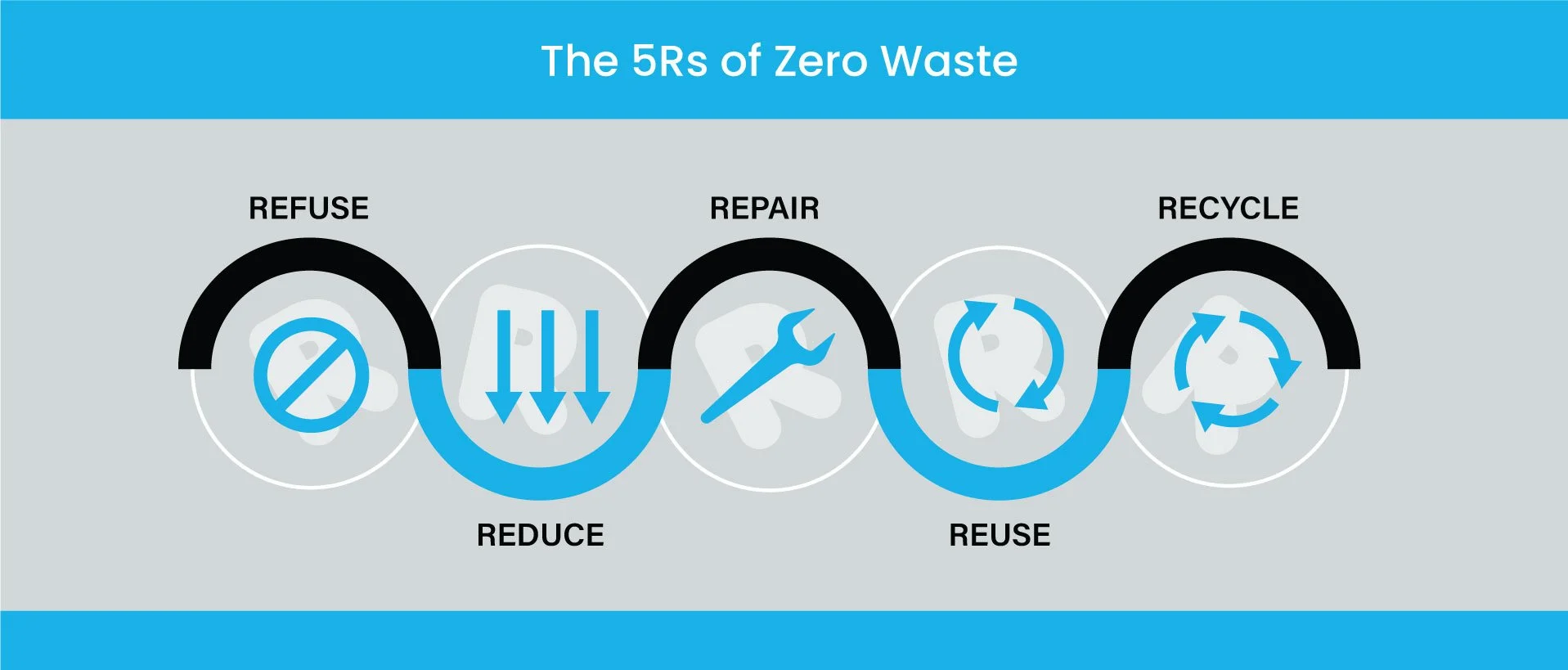How the 5Rs of Zero Waste Can Change the Narrative for End-of-Life Solar Panels
In our efforts to fight climate change, solar power is an increasingly important source of renewable energy. Falling costs and increased accessibility (thanks to both growing popularity and government programs like the Inflation Reduction Act of 2022) have resulted in a clean energy boom.[1] In the last decade, solar has experienced an average annual growth rate of 33%—with fewer than 1,000 installations in 2010 and more than 20,000 installations in 2020.[2]
But exponential growth has its challenges—namely waste. Industry watchers like the Harvard Business Review, SEIA, and others are sounding the alarm about how a booming solar industry could lead to tons of toxic trash in the form of end-of-life solar panels.[3], [4] In the end, it will be the rate at which our industry is willing to implement a circular economy framework that will define our legacy.
78 million metric tons of solar panels will reach end-of-life by 2050—enough to cover more than 1,000,000 American football fields.
THE LOOMING PROBLEM
Big Boom = Big Trash
Global projections made by the International Renewable Energy Agency show that 78 million metric tons of solar panels will reach the end of their life by the year 2050—which translates into about 6 million metric tons of solar e-waste every year.[5], [6], [7] Here’s a shocking visual: the solar panels that are due to retire by 2050 would cover more than 1,000,000 American football fields.[8] Domestically, the EPA expects the US to see 10 million tons of end-of-life panels by 2050—second only to solar waste projections from China.[9], [10]
Complicating those numbers is a tech truth that society has proven time and again over the past few decades: the faster we innovate, the sooner we’re ready to fall out of love with yesterday’s model and pick up that shiny new iPhone, computer, watch, etc. In other words, innovation drives accelerated replacement—and our industry isn’t immune to that trend.[11], [12], [13] In fact, early replacement of solar PV modules could translate to 50 times more waste than the IREA and EPA projections—in just 4 years. For those who don’t have their calculators handy, that’s the equivalent of 315,000 million metric tons of solar waste.[14]
Why Not Recycle?
In a green industry like ours, what might seem like an obvious solution to the impending flood of waste—recycling—can actually be one of the most elusive.
That’s partially because recycling PV solar modules is difficult and expensive. Fabrications and compositions vary from panel to panel. Bespoke, hard-to-scale recycling processes are often required to separate silicon, lead, copper, and silver from the glass that sandwiches it on both sides.[15] Little wonder, then, that recycling a single panel can cost between $12 to $30, whereas it would only cost $1 to $2 to send that same panel to a landfill.[16], [17] Consequently, only about 10% of panels are recycled in the US and Europe, while the rest wind up in landfills.[18]
Only about 10% of solar panels are recycled—the rest end up in landfills.
But there’s a bright side: because we’re a relatively young industry, this doesn’t have to be our legacy. We have an opportunity to design and build the necessary infrastructures to cut recycling costs, create widespread availability and access, and solve the problem before it becomes one.[19], [20], [21]
By integrating the 5Rs of Zero Waste—refuse, reduce, repair, reuse, recycle—we can change the narrative and pave the path to a greener future for the solar industry.
THE 5R SOLUTION
Bypassing the Landfill
Much like those tech trends in the past, end-of-life waste is an essential discussion—and a problem the solar industry is actively trying to solve. Companies like SolarCycle, Fabtech, and Green Clean Solar are leading the charge in addressing end-of-life solar modules by focusing on three of the Rs: repair, reuse, and recycle.
SolarCycle—a member of SEIA’s National PV Recycling Program—partners with the solar industry to provide end-of-life, affordable recycling solutions that recover 95% of the valuable materials from each panel their facility processes.[22] Nodding to the unprecedented number of panels that will be necessary to fully transition the globe to solar power, SolarCycle’s efforts to recover materials from retired panels for use in new ones eases the industry’s dependence on mining raw materials.[23], [24] They also estimate that each recycled panel avoids the emissions of 97 pounds of CO2.[25]
However, not all decommissioned solar panels need to be recycled. An increasing number of decommissioning projects are happening prior to the end of the solar system’s lifecycle.[26] Fabtech Solar Solutions is in the business of giving usable solar panels a second life. By purchasing those decommissioned panels, repairing them, and making them available for reuse in a secondary market, Fabtech Solar Solutions helps provide solar energy to people at a much lower cost. Their commitment to no-landfill disposal plans and innovative refurbishment and recycling solutions help further solar circularity.[27]
Green Clean Solar attacks the waste issue by delivering scalable landfill diversion efforts to solar sites across the United States. They help companies achieve landfill-free status as they promote responsible packaging practices and work to connect installers with recycling and refurbishing centers.[28], [29] Even better, they make the process easy, even painless. In a recycling environment as complex as our current one, Green Clean Solar is offering solar developers and decommissioners a seamless way to integrate reuse, repair, and recycle into their process.
But repair, reuse, and recycle only make up 3/5 of the equation. We need to build on the efforts of trailblazers like SolarCycle, FabTech, and Green Clean Solar by taking the extra steps to be preemptive about the problem.
Preventing Damage
Future onslaughts of retired and decommissioned panels are the focus of industry watchers right now. But that’s not the whole story of solar waste. Industry-wide, an estimated 5% of solar panels shipped on traditional wood pallets are broken in transit, resulting in 21 million broken modules and $5.25 billion in global losses each year.[30]
An estimated 5% of solar panels shipped on traditional wood pallets are broken in transit, resulting in 21,000,000 broken modules each year.
Let’s talk about that 5% breakage rate. A circular economy engineers waste out of the supply, production, use, reuse, recycle chain. While end-of-life modules and the need to reuse and recycle is obviously a big part of the equation, those 21,000,000 modules could be prevented from ever needing to be recycled or trashed in the first place. We can reduce solar module waste just by changing the packaging.
Shipping solar modules in a reinforced, reusable, customizable pallet system protects them on their way to the job site and reduces both packaging waste and solar module damages. Case studies show a 92-100% reduction in module breakage with PVpallet Series X.[31], [32]
Utilizing a quality pallet to protect solar modules doesn’t just mean fewer broken new panels, it also means fewer broken retired panels. Protecting decommissioned panels is far more important than many realize—for both decommissioning and recycling. Decommissioned PV panels that are protected and arrive to their destination undamaged can then feed a secondary market. Reuse stimulates the US economy and supports an even more sustainable solar power system.[33] When it comes to recycling, damaged solar panels cost more to recycle. In fact, too much damage makes recycling a PV module impossible—forcing recyclers to relegate it to a landfill.
Refusing Waste
Here’s the good news: while our industry has yet to hone the sustainable, user-friendly infrastructures needed for widespread solar reuse, repair, and recycling, each and every solar organization can work toward a better future now.
Every purchase we make is a vote for the future.
That means we can continue to vote for excessive solar waste by purchasing panels shipped on traditional wood pallets. We can continue to accept the inevitable result: mountains of discarded solar panels rising out of our landfills on top of all that flimsy packaging we couldn’t be bothered to change.
Or we can make a different choice.
The truth is, we have a say in how many panels wind up in landfills. We can control how many are damaged beyond reuse or even recycling. The truth is, we can refuse solar waste narratives one shipment, package, and panel at a time. Every time we choose packaging that protects our solar modules and keeps them out of landfills or take the steps to repurpose or recycle used solar modules, we are casting a vote for a greener future.
Together, we can change the narrative.
Related Articles
Sources
[1] https://www.pvpallet.com/news/benefit-from-a-clean-energy-future-through-the-inflation-reduction-act
[2] https://www.seia.org/solar-industry-research-data
[3] The Dark Side of Solar Power (Harvard Business Review) https://hbr.org/2021/06/the-dark-side-of-solar-power?utm_source=pocket_saves
[4] Recycling & End-of-Life Considerations for Photovoltaics https://www.seia.org/initiatives/recycling-end-life-considerations-photovoltaics
[6] The Dark Side of Solar Power (Harvard Business Review) https://hbr.org/2021/06/the-dark-side-of-solar-power?utm_source=pocket_saves
[7] Solar Panels Are Starting to Die, Leaving Behind Toxic Trash https://www.wired.com/story/solar-panels-are-starting-to-die-leaving-behind-toxic-trash/?utm_source=pocket_saves
[8] PVpallet Numbers https://www.pvpallet.com/math
[9] End-of-Life Solar Panels: Regulations and Management https://www.epa.gov/hw/end-life-solar-panels-regulations-and-management
[10] The Next Big Thing in Recycling: Expired Solar Panels https://www.motherjones.com/environment/2023/04/recycling-solar-panels-silver-copper-waste-landfill/?utm_content=246799952&utm_medium=social&utm_source=linkedin&hss_channel=lcp-3960972
[11] Reducing Loss of Resources From Waste Management is Key to Strengthening the Circular Economy in Europe https://www.eea.europa.eu/publications/reducing-loss-of-resources-from/reducing-loss-of-resources-from
[12] The Dark Side of Solar Power (Harvard Business Review) https://hbr.org/2021/06/the-dark-side-of-solar-power?utm_source=pocket_saves
[13] https://www.solarcycle.us/
[14] The Dark Side of Solar Power (Harvard Business Review) https://hbr.org/2021/06/the-dark-side-of-solar-power?utm_source=pocket_saves
[15] Solar Panels Are Starting to Die, Leaving Behind Toxic Trash https://www.wired.com/story/solar-panels-are-starting-to-die-leaving-behind-toxic-trash/?utm_source=pocket_saves
[16] Solar Panels Are Starting to Die, Leaving Behind Toxic Trash https://www.wired.com/story/solar-panels-are-starting-to-die-leaving-behind-toxic-trash/?utm_source=pocket_saves
[17] The Dark Side of Solar Power (Harvard Business Review) https://hbr.org/2021/06/the-dark-side-of-solar-power?utm_source=pocket_saves
[18] Solar Panels Are Starting to Die, Leaving Behind Toxic Trash https://www.wired.com/story/solar-panels-are-starting-to-die-leaving-behind-toxic-trash/?utm_source=pocket_saves
[19] The Next Big Thing in Recycling: Expired Solar Panels https://www.motherjones.com/environment/2023/04/recycling-solar-panels-silver-copper-waste-landfill/?utm_content=246799952&utm_medium=social&utm_source=linkedin&hss_channel=lcp-3960972
[20] Solar Panels Are Starting to Die, Leaving Behind Toxic Trash https://www.wired.com/story/solar-panels-are-starting-to-die-leaving-behind-toxic-trash/?utm_source=pocket_saves
[21] Solar Panel Recycling https://www.epa.gov/hw/solar-panel-recycling
[22] https://www.solarcycle.us/
[23] https://www.solarcycle.us/
[24] Mining Ray Materials for Solar Panels: Problems and Solutions https://blog.ucsusa.org/charlie-hoffs/mining-raw-materials-for-solar-panels-problems-and-solutions/
[25] The Next Big Thing in Recycling: Expired Solar Panels https://www.motherjones.com/environment/2023/04/recycling-solar-panels-silver-copper-waste-landfill/?utm_content=246799952&utm_medium=social&utm_source=linkedin&hss_channel=lcp-3960972
[27] https://fabtech.net/
[28] https://www.greenclean-solar.com/
[29] Entrepreneurs Finally Bring Real Sustainability to Solar https://www.solarpowerworldonline.com/2023/01/entrepreneurs-finally-bring-real-sustainability-to-solar/
[33] What It Takes To Realize a Circular Economy for Solar Photovoltaic System Materials https://www.nrel.gov/news/program/2021/what-it-takes-to-realize-a-circular-economy-for-solar-photovoltaic-system-materials.html






